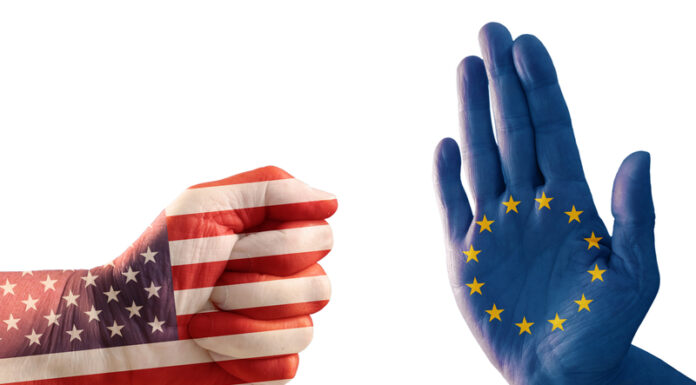President Donald Trump has finalized significant trade agreements, surprising critics who doubted the effectiveness of his aggressive negotiating tactics. These accords are expected to channel hundreds of billions of dollars in new investments into the United States.
The centerpiece of these achievements is Trump’s extensive trade agreement with the European Union. The deal establishes a 15% tariff on most EU goods, while Europe agrees to purchase $750 billion in U.S. energy and to invest an additional $600 billion in American businesses by 2028.
Trump announced the EU agreement on July 27, 2025, following a meeting with European Commission President Ursula von der Leyen at his golf resort in Scotland. During the announcement, the president described it as the “biggest deal ever made.”
The agreed-upon 15% tariff rate is significantly higher than the roughly 1% average that was in place before Trump assumed office. However, it remains below the 30% punitive tariffs Trump had threatened to impose if Europe failed to reach an agreement by his August 1 deadline.
As part of the accord, Europe will eliminate all tariffs on American industrial goods, providing expansive new opportunities for U.S. manufacturers. Additionally, the EU has agreed to purchase American military equipment and offer U.S. companies enhanced access to European consumers.
Von der Leyen informed reporters that the negotiations were “indeed very tough,” but resulted in a beneficial outcome for all parties involved.
Trump’s successful dealings with Europe followed a historic agreement with Japan. The agreement with Japan involves a $550 billion investment fund directed by Trump, aimed at revitalizing American industries such as energy, computer chips, pharmaceuticals, and shipbuilding.
The Japanese agreement marks the largest foreign investment commitment secured by any country. Japan will face a 15% tariff on its goods, similar to the rate agreed with Europe.
Under the terms of the Japan deal, the U.S. will receive 90% of the profits from the investment fund, while Japan will open its markets to American cars, trucks, and agricultural products. Japan has also committed to purchasing 100 Boeing aircraft and increasing rice imports from the U.S. by 75%.
Trump highlighted the Japan agreement during a meeting with Republican lawmakers, stating he had “signed the largest trade deal in history” with the Asian nation.
Prior to his August 1 deadline, Trump secured deals with other nations. Indonesia agreed to a 19% tariff while removing nearly all taxes on American products. In exchange, Indonesia will purchase $15 billion in U.S. energy and $4.5 billion in American agricultural products, along with 50 Boeing jets.
The Philippines accepted similar terms, involving a 19% U.S. tariff while eliminating all taxes on American exports. Vietnam reached a preliminary agreement, though specific details remain undisclosed. The United Kingdom received favorable terms, including lower tariff rates, in return for increasing its purchases of American agricultural products and energy.
Even China reached an agreement that reduces previous tariffs from 145% to 30% for the U.S. and from 125% to 10% for China. This temporary agreement, signed in May, is set to expire on August 12, with ongoing negotiations.
The successful agreements demonstrate that Trump’s strategy of threatening high tariffs to secure better terms has been effective. Despite skepticism from experts who predicted that his approach would harm the American economy, major economies have accepted significantly higher taxes on their goods to maintain access to American consumers.
Countries that missed Trump’s deadline face harsher penalties. Canada will incur 35% tariffs despite ongoing discussions, while India faces 25% tariffs plus additional penalties for purchasing energy from Russia. Other nations without deals face tariffs ranging from 25% to 50%.
Stock markets responded positively to the agreements. European markets climbed to four-month highs following the EU deal, while Japan’s main stock index increased by 3.7% after Trump’s announcement.
German Chancellor Friedrich Merz praised the EU deal, noting that it prevented “a trade conflict” that could have seriously impacted Germany’s export economy.
However, not all reactions were positive. Some European officials criticized the agreements as unfair, with French Prime Minister François Bayrou describing the EU agreement as a dark day for Europe. Nonetheless, most leaders acknowledged that the agreements were preferable to much higher tariffs.
American business groups and farmers welcomed the agreements. Industry leaders indicated that the deals provide certainty and open new markets that were previously challenging to access.
Collectively, the agreements encompass nearly half of the global economy and establish new norms for international trade. The Trump administration asserts that these deals will create hundreds of thousands of American jobs while revitalizing key industries within the United States.
These unprecedented deals highlight that Trump’s unconventional negotiating style can yield results unattainable through traditional diplomacy. By leveraging America’s vast economy, Trump compelled other countries to accept terms that significantly favor American workers and businesses.








